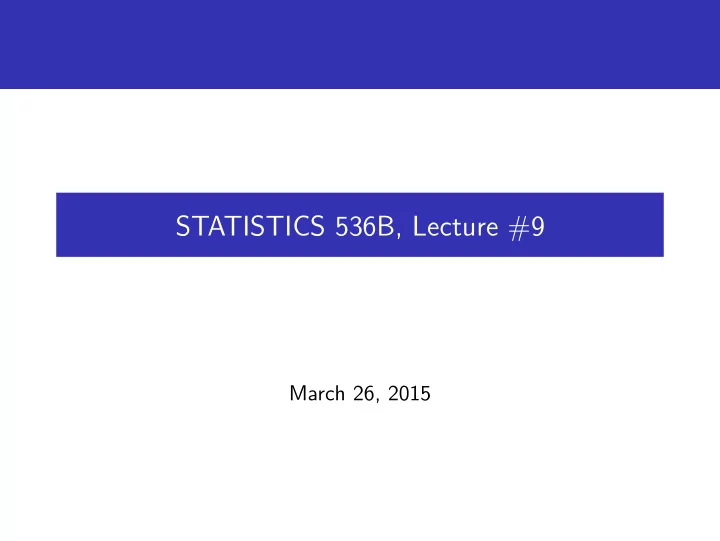

STATISTICS 536B, Lecture #9 March 26, 2015
Propensity scores - What is the high level idea? Have ( Y , X , C 1 , . . . , C p ) data, interested in the association between Y and X given C . Direct route: study this via regression of Y on X and C . Indirect route: consider Z = Pr ( X = 1 | C ) = π ( C ) (in theory), or ˆ Z = ˆ π ( C ) (in practice). Then focus on the association between Y and X given Z . The underlying mathematics validates this approach.
Mongelluzzo et. al. - corticosteroids and mortality from bacterial meningitis Outcome Y is time-to-event (time from hospitalization for bacterial meningitis to death, or time from hospitalization to discharge) Binary exposure X is adjuvant use of corticosteroids Potential confounders ( C ) include sex, race, vancomycin use within 24 hours, etc,... Traditional analysis might involve proportional hazards regression model for Y using X and C 1 , . . . , C p as explanatory variables. Instead, these authors use X and ˆ Z = ˆ π ( C ) as the explanatory variables.
Some discussion points Fitted propensity model for ( X | C ) model gives AUC=0.74 ... “better than chance,´ ’but “little concern about nonoverlapping propensity score distributions” ???
Discussion points, continued But then: “The propensity scores were not equally distributed. When the propensity scores were stratified by quintiles, a greater proportion of X=1 patients were in the highest quintile and a greater proportion of X = 0 patients were in the lowest quintile. To address this imbalance...” PUZZLING!!!
Discussion points, continued ‘Residual confounding by indication’ concern. Often plausible that sicker patients more likely to get the intervention ( X = 1) being studied. (So a crude two group comparison would be ‘unfair’ on X = 1). Not a problem if ‘sicker’ is completely captured by C . Otherwise, can make an intervention appear less efficacious than it really is. E.g., say that ( C , C ∗ ) completely capture ‘sicker’, but C ∗ is unmeasured.
Results Table 3: no evidence for a ( Y , X ) association given C - for either Y . Table 4: no evidence for a (Cost , X ) association given C . Suggestive of (or at least consistent with) C being ‘good enough.’ Plausible that if C wasn’t fully capturing disease severity and X = 1 was being preferentially offered to those with more severe disease, then we would see a positive association between X and Cost given C .
Back to simpler framework of continuous outcome Y . Where are we at? Trying to estimate ∆ = E { E ( Y | X = 1 , C ) − E ( Y | X = 0 , C ) } . If we are confident in our ability to model Y given X and C : Could fit a ( Y | X , C ) outcome model, to estimate m x ( C ) = E ( Y | X = x , C ), then n 1 ˆ � ∆ R = m 1 ( c i ) − ˆ ˆ m 0 ( c i ) n i =1 is a consistent estimator, if the form of the outcome model is right.
Or the propensity route If we are confident in our ability to model X given C : Recall (last time) we can rewrite the target parameter as � X � 1 − X �� ∆ = π ( C ) − E Y 1 − π ( C ) Could fit a ( X | C ) propensity model, to estimate π ( C ) = Pr ( X = 1 | C ), then � x i n 1 1 − x i � ˆ � ∆ IPW = y i π ( c i ) − . ˆ 1 − ˆ π ( c i ) n i =1 is a consistent estimator if form of propensity model is right.
Back to nasty dataset from last time ### outcome model and fitted values outmod <- lm(y~x+cnf) m0 <- cbind(1,0,cnf)%*%coef(outmod) m1 <- cbind(1,1,cnf)%*%coef(outmod) ### propensity model and fitted values promod <- glm(x~cnf, family=binomial) prpns <- fitted(promod, response=T) ### regression estimate mean(m1-m0) [1] 1.23 ### IPW estimate mean(y*(x/prpns - (1-x)/(1-prpns))) [1] 1.14 ### Double-robust estimate mean((y*x - (x-prpns)*m1)/prpns) - mean((y*(1-x) + (x-prpns)*m0)/(1-prpns)) [1] 1.16
Standard errors for these estimates? All three estimates are means of n values, but . . .
So bootstrap... ests.bb <- matrix(NA,200,3) for (i in 1:200) { smp <- sample(1:n, replace=T) ### outcome model outmod <- lm(y[smp]~x[smp]+cnf[smp,]) ... ### propensity model promod <- glm(x[smp]~cnf[smp,], family=binomial) ... ests.bb[i,] <- c(mean(m1-m0), ...) } sqrt(apply(ests.bb,2,var)) [1] 0.12 0.12 0.12
Recommend
More recommend